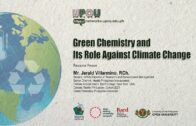Nucleosynthesis: Formation of the Elements | Prof. Ramon Carlo L. Cruzpero
Nucleosynthesis: Formation of the Elements
Prof. Ramon Carlo L. Cruzpero
Most of us are fond of watching fireworks display. During festivals like our very own Lantern Parade, we usually anticipate for a spectacular fireworks display to cap off the events. When you are in the company of science people, my usual kind of crowd, fireworks display watching may at times lead to a guessing game, “Which element or elements were used in the creation of such spectacular colors?”
My take away in this kind of nerdy—or shall we say educational discussion—is rooted from one key point: the chemical elements. But what are chemical elements?
We have encountered this term in our chemistry class and defined it as the building blocks of matter. We also have known that a chemical element is composed entirely of one kind of atom. Now, where do these chemical elements really come from? How were they created? These questions are answered when we study nucleosynthesis. This is a theory which explains the formation of the chemical elements that we know today.
In the storyline of the birth of the universe, there are three identified cosmological settings where these elements were believed to have been created. These are the Big Bang, the Stars and the Supernova.
In the early parts of the Big Bang timeline, as the temperature cooled down, the massive energy brought by the Big Bang created the fundamental particles such as the leptons and the quarks. Due to the relatively high temperature, these newly created particles were moving so fast that a number of collisions among them happened but they weren’t able to combine. As the temperature continued to decrease, due to the expansion of the universe, these fundamental particles were able, then, took, interact and combine to form the atomic particles, namely, the neutrons and the protons.
With a further continued decreasing temperature, these atomic particles interact with one another to form the first two elements in the universe: helium and hydrogen.
There were some traces of Lithium and the Beryllium formed due to the formation processes of the first elements, particularly in one of the formation processes of helium, but the early Lithium and Beryllium were unstable and they decay into more stable elements most likely helium-4 or the isotopes of the first two elements.
There are a number of processes in the formation of the helium element. But according to George Gamow, the formation process of Helium-4 may take three steps as shown in this illustration. The first step involves two separate interactions of a neutron and a proton which each create a deuteron. A deuteron composed of a neutron and proton is the nucleon of the deuterium, an isotope of hydrogen.
The second step involves the interaction of two deuterons which results to an ejected neutron and the formation of Helium-3 atom. Helium-3 atom is an isotope of Helium-4 and is considered as one of the most stable isotopes in the universe. On the other hand, the ejected neutron may interact with another proton to form another deuteron or may interact with another deuteron to form tritium which is another isotope of hydrogen.
The third step is the interaction of Helium-3 and a deuteron. This will result to the formation of Helium-4 with two protons and two neutrons and an ejected proton. The ejected proton may interact with a neutron to form a deuteron or interact with another deuteron to form Helium-3.
On the other hand, hydrogen was created when a proton attracts an electron to revolve around it. At first, there were only few hydrogen atoms created, as the electrons were still moving fast due to the relatively high temperature. But, as the temperature continued to decrease, these elections gradually slowed down and a proton had a higher chance to attract an electron.
Because of the simplicity of this process, this is the reason why hydrogen is the most abundant element in the universe. For a hydrogen atom to become more stable, it attaches to another hydrogen atom, thus, forming a hydrogen molecule. These hydrogen molecules, together with helium atoms, clump together to form molecular dense clouds which are the main ingredients of the formation of stars.
The stellar evolution helps us in tracing the formation of the other elements. The life of a star generally begins when a gravitational collapse of cool, dense molecular clouds happen. As these clouds collapse, they fragment into smaller regions which themselves contract to form stellar cores, the protostars.
These protostars rotate faster and increase in temperature as they condense, and further contract. As the protostar contracts the central temperature increases to the point of igniting a series of nuclear reactions. This is also the beginning of the main stages of the hydrostatic stellar evolution where stellar nucleosynthesis occurs.
The first stage of the series of nuclear reactions is called the hydrogen
burning stage, where the hydrogen core is converted to heavier elements. The
nuclear reactions that happen in this stage depends on the mass of the star. If
the star is a low mass star—that means, a star with mass less than eight times our sun’s mass—Proton-Proton Interaction or PPI takes place in converting the hydrogen core into helium. This interaction has three chains, and 84% of the nuclear reactions that occur on this type of star are in the chain one reaction, while the remaining percentage are in the chains two and three reactions.
The PPI reaction creates a new inner core which is made of helium. Once the hydrogen shell fusion is almost depleted the newly formed helium core contracts thereby, increasing the inner temperature and at the same time increasing the energy generation rate of the hydrogen shell. With the increased energy generation rate at the hydrogen shell, this causes the star to expand enormously in luminosity and size. The star becomes a red giant.
The contracting helium core begins another nuclear reaction, this is the helium burning stage. At this stage, the inner parts of the helium core is burned to create another core made of carbon with some specks of oxygen via the triple alpha process. An alpha particle is a nucleon of Helium-4 which is composed of two neutrons and two protons.
This is the last stage of the series of nuclear reactions for low mass stars. As the low mass star depletes its source of energy generation, the two outermost shell—the hydrogen in the helium shells—asynchronously contract and expand under such time these are dispersed from the star and form a planetary nebula. What is left is a white dwarf star, which is the last inner core created in this stellar evolution.
For high mass stars, stars which have masses greater than eight times our sun’s mass, Carbon-Nitrogen Nitrogen-Oxygen or CN-NO bicycle, also known as Carbon-Nitrogen-Oxygen or CNO cycle, may take place in the hydrogen burning stages. The series of nuclear reactions does not stop with carbon core on this type of star. It continues until an iron core with some percentage of nickel is made. Once an iron core is made, no further nuclear reactions will follow. It is said that iron is the most stable element based on its mass per nuclear particle ratio as shown in the graph.
Now, how about the remaining elements?
The remaining elements were created during the biggest fireworks display in the universe, the supernova—thus, the name supernova nucleosynthesis. Supernovae happen when high mass stars deplete their source of energy generation which leads to explosive endings. In this stage of the stellar evolution, all elements were formed, but almost all were unstable which lead them to either decay into lighter stable element or they cease to exist.
Now, what’s so similar about the fireworks display and the supernova?
Both of them make big explosions and spectacular colors. The main difference between the two is that the temperature and pressure is too high in the supernova that it can create spontaneous nuclear reactions to form the heavier elements. While in the fireworks, the temperature is enough to ignite the appearance of the emission spectrum of the chemical elements. But after this lecture, you may have a thing or two that you can share to your friends.
How useful was this resource?
Click on a star to rate it!
Average rating 5 / 5. Vote count: 1
No votes so far! Be the first to rate this post.
We are sorry that this post was not useful for you!
Let us improve this post!
Tell us how we can improve this post?































